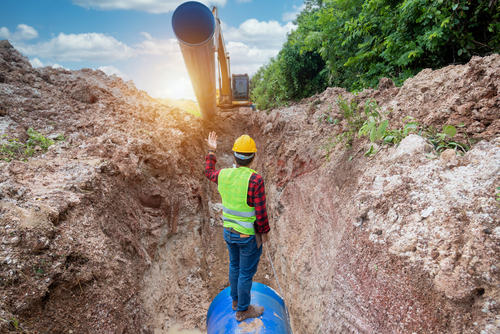Trench Safety Tips for Construction Workers
 Trench safety is an important consideration at construction sites. But, workers who understand the hazards of trenching and excavation can minimize the risk of cave-ins and other worksite dangers.
Trench safety is an important consideration at construction sites. But, workers who understand the hazards of trenching and excavation can minimize the risk of cave-ins and other worksite dangers.
What is trenching in construction, and how can your company ensure all employees understand your safety platform? ForkliftCertification.com (FLC) offers three different courses and packages to get your employees up to speed on the latest excavation safety standards. Trenching and excavation require extra caution – both from the workers in the trench, and also from other workers near the trench, including forklift operators.
Sign up today with FLC and enjoy affordable, accurate, up-to-date safety training today!
What Is the Difference Between an Excavation and a Trench?
OSHA defines an excavation as a manmade cavity, cut, or depression in the earth’s surface created by removal of earth. Comparatively, OSHA defines a trench as a narrow underground excavation that has a maximum width of 15 ft. and tends to have a depth that exceeds its width.
While excavation refers to the general act of digging and removing earth and other debris, trenches are more specialized. Trenches may be required by construction crews to lay underground pipes & communication cables, install utilities, access water systems, repair damaged components, and much more.
For example, highway crews utilize trenches to access and install drainage systems, including box culverts, drainage pipes and other items associated with water control.
Cave-ins are the most prominent risk associated with excavations and trenches, according to OSHA. In addition, OSHA points out that construction workers may be exposed to falls, falling loads, and other hazards any time they complete tasks in excavations or trenches.
TYPES OF EXCAVATION PROJECTS
There are 3 main types of excavations – all of which require trench safety precautions:
Earth & topsoil excavation
This is where the top layer of soil is removed, along with underlying rock and other material. Earth & topsoil is the most common type of excavation.
Muck excavation
Sounds messy – and it is! Think of muck trenching and excavation as regular topsoil excavation, plus tons of moisture and water. The main goal here is to remove or reduce the amount of water in order to create a more stable working environment.
Non-classified excavation
Much, rock, topsoil, water, you name it…this is called non-classified (or unclassified) trenching and excavation. This type of excavation must be completed according to engineering plans, regardless of the moisture contained. As you’d might expect, this is the “wildcard” of trenching, and workers must adhere to special precautions and excavation safety guidelines.
Trenching and Excavation Safety Tips
Construction companies must comply with OSHA’s trenching and excavation requirements. In doing so, they can implement the proper measures to protect their workers against trenching and excavation dangers.
Furthermore, there are several things that construction workers can do to protect themselves when they work in trenches or excavations, including:
1. Avoid Entering an Unprotected Trench
Construction workers should only enter a trench after a worksite job safety analysis has been performed.
2. Leverage Appropriate Safety Systems
Sloping, shoring, and shielding are among the protective systems that construction workers can use to protect themselves against trench and excavation accidents, injuries, and fatalities. Sloping and benching techniques are important, and OSHA trench safety standards should always be followed.
3. Ensure Entry and Exit Points Are in Place
Trench and excavation entry and exit points must be established based on the number of construction workers at a worksite; these points should be clearly marked and easy to access.
4. Inspect trenches on a regular basis
Regular inspections are critical for trenching and excavation safety. Many trench collapses and cave-ins can be avoided with routine inspections…make them part of your regular OSHA trench safety guidelines!
5. Have a Competent Person on Hand
OSHA stipulates that a “competent person” must inspect a trench to verify its safety; if this individual identifies any hazards, these issues must be corrected immediately.
Along with using the aforementioned tips, construction workers who perform tasks in trenches or excavations must:
- Keep forklifts and other heavy equipment away from the edge of a trench
- Know where any underground utilities are located near a worksite
- Perform tests to determine if low oxygen, hazardous fumes, and toxic gases are present
- Avoid working under raised loads
- Inspect trenches at the start of each work shift
- Evaluate trenches after a rainstorm
- Ensure surcharge loads remain at least 2 ft. from trench edges
6. Test for Dangerous Gas
Safe trenching and excavation not only require sufficient oxygen – they also should have no dangerous gas like carbon dioxide and methane. Check out OSHA’s guidelines and suggestions for atmospheric testing.
GET COMPLIANT TODAY WITH FORKLIFTS, TRENCH SAFETY & MORE – SIGN UP WITH FLC
Want to ensure the safest possible working environment? Enroll your workers in an OSHA certification training program. In fact, with the forklift certification safety training program available from ForkliftCertification.com, construction workers can quickly and easily become OSHA-certified forklift operators.
Many of the common sense safety precautions found in trench safety parallel safe forklift use, including the adherence to OSHA guidelines. Your company can’t afford the cost of non-compliance…and your employees deserve the best safety training, so sign up with FLC today!
FLC’s forklift certification safety training program teaches construction workers about all aspects of forklift safety and can be completed in as little as one hour. To learn more about our program or to enroll your workers in it, please contact us online or call us today at (888) 278-8896.
